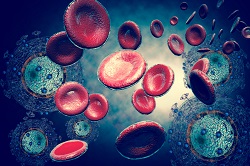Trending Science: New HIV treatment appears to have fully erased the virus from a patient’s blood
The trial, run by five British universities and the UK’s National Health Service (NHS) highlights that the initial signs are indeed very promising. However it’s too soon to say that it’s a cure just yet, with the researchers pointing out that there is still the chance that the virus may return and that the presence of anti-HIV drugs in the patient’s body could make it difficult to ascertain whether all traces of the virus are gone for good. ‘This is one of the first serious attempts at a full cure for HIV,’ Mark Samuels, Managing Director of the National Institute for Health Research Infrastructure told Britain’s ‘The Sunday Times’. ‘We are exploring the real possibility of curing HIV. This is a huge challenge and it’s still early days but the progress has been remarkable.’ HIV has long been difficult to treat due the virus’s ability to effectively hide in dormant cells where the immune system is unable to reach it and destroy it. The new therapy aims at eradicating HIV from every part of the body, and works by combining a drug that reactivates these dormant HIV cells with a vaccine designed to help the immune system locate and kill them. Specifically, the vaccine is given to the patients first, boosting the immune system’s ability to detect and combat HIV-infected cells and then a drug called Vorinostat is used. The drug activates the dormant HIV cells left over, allowing the immune system to find and fight them. This is called a ‘kick and kill’ strategy. So far, 39 out of a total of 50 have been recruited to the trial. The first patient to have finished the ‘kick and kill’ strategy that appears to have been successful is a 44 year-old male. He is currently showing no signs of the virus in his blood. However he has also, along with the other participants, been taking standard antiretroviral drugs whilst taking part in the trial. We will only know if the virus has been truly eradicated from his body once the antiretroviral drugs wear off. When this happens and if the virus is confirmed to have been eliminated from his body, he would be just the second person in the world to ever be cured of the disease, one which affects the lives of some 37 million people worldwide. The first person to be cured of HIV, the American Timothy Ray Brown, was given a bone marrow transplant from a donor known to be resistant to the disease, which allowed for his immune system to rebuild and eradicate the virus. However, this kind of treatment is expensive and too dangerous to be used widely, hence why this new breakthrough is causing such excitement. All of the trial volunteers are newly infected HIV patients. This means that they have a small viral load and their immune system has not yet been badly damaged by the virus. It is thought that if HIV can be cured, then these patients represent the easiest cases in which to achieve this goal. Consequently, even if the trial is a success, there is no guarantee that this treatment would be successful for patients who have been infected for a much longer time. As such, no one is taking anything for granted yet – even the British male patient who first succeeded in finishing the trial. ‘I took part in the trial to help others as well as myself,’ he commented to ‘The Sunday Times’. ‘It would be a massive achievement if, after all these years, something is found to cure people of this disease. The fact that I was part of that would be incredible.’ With tangible results from the trial not expected until early 2018, all we can do now is wait… and hope.
Countries
United Kingdom



